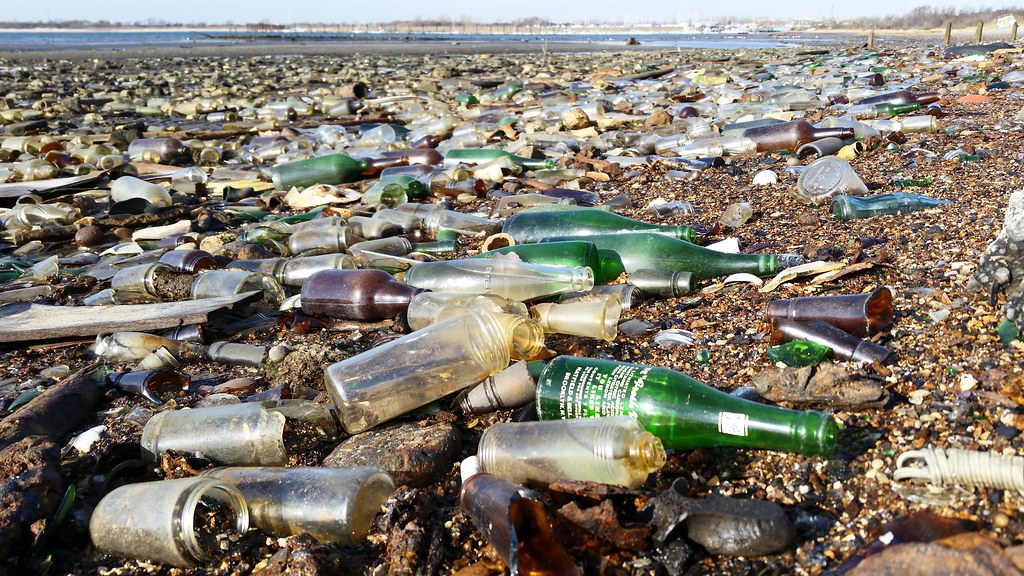
Many decades ago, Dead Horse Bay was a little finger of water protruding into Barren Island, the southernmost of a group of marshy islands that once lay off the coast of Brooklyn at the mouth of Jamaica Bay. Barren Island was infamous for the more than two dozen malodorous industrial enterprises that called it home over the years. According to the NY Times:
From the 1850's until the 1930's, the carcasses of dead horses and other animals from New York City streets were used to manufacture glue, fertilizer and other products at the site. The chopped-up, boiled bones were later dumped into the water. . . .The city stopped sending garbage to Barren Island in 1919. And as the automobile became more popular, "the number of horse carcasses in Dead Horse Bay dwindled . . . and by the 1920's only one rendering plant remained."
In the 1860's, fish oil plants were established along Dead Horse Bay. The oil was used to tan leather and mix paints and the scraps were used to make fertilizer. When the factories faded in the 1890's, the New York Sanitary Utilization Company was established to transform city garbage into grease, soap and fertilizer. The processing and horse-rendering industries, at their peak, supported a population of 1,500. Barren Island, however, had no public water, sewage system or fire department, and nearby communities complained endlessly about the horrendous stench of its factories.
In the late 1920s, to create a site for Floyd Bennett Field, the city's first municipal airport, Barren Island and its neighbors were transformed into a peninsula, connected to each other and the Brooklyn mainland (a.k.a. Long Island) with millions of cubic yards of sand pumped up from Jamaica Bay. The airport opened in 1931, and the final rendering plant on what had been Barren Island closed around the same time.
According to Robin Nagle, the anthropologist-in-residence at the Department of Sanitation, the bottles and other items lying on the beach of Dead Horse Bay (the name has lived on even as the geography has been radically altered over the years) were dumped there in 1953:
All this stuff got here when Robert Moses was expanding the landfilling of garbage around the city, which was especially urgent after the United States Supreme Court told New York it could no longer dump garbage at sea, which we had been doing for centuries. That Supreme Court order took effect in 1934. From that point forward, we started building landfills and incinerators all over the city. Everything we see here was placed here sometime between early February and mid-March of 1953, and it's all from somewhere in Brooklyn — I'm not exactly sure where yet, but I'm working on that — and these are homes, the debris from homes that were razed to make way for various forms of urban renewal and highway construction.Howard Warren, who has been visiting the shoreline of Dead Horse Bay (now part of Gateway National Recreation Area) since 1987, says he didn't start seeing debris emerging on the beach until 1991, but now more and more of the old landfill is being uncovered every day.
You can read a little about life on Barren Island here, and see some old photos of the place here. A lengthy 1899 Brooklyn Daily Eagle article about the island (part 1, part 2) offers an enthusiastic report on the garbage-processing and animal-rendering plants, from which I have excerpted the following:
Not many of the millions of persons who make up the throngs on New York's thoroughfares know that there is gold in the garbage they see scattered over the streets and lying in the gutters. Fewer still know the method by which the gold is extracted. To the average member of the great public the banana peels, watermelon rinds, dirty rags, tin cans, rotted fruits and decaying vegetables are simply parts of a great nuisance. They are of no value and only of importance because they are an offense to both the senses of sight and smell and a menace to the public health. . . .
But this same garbage is worth $2,000,000 a year. That is very nearly the exact sum annually realized from the filthy stuff after it has passed through the plant of the New York Utilization Company, which disposes of all the garbage of the City of New York. Two big twin factories on the extreme eastern end of Barren Island convert the kitchen refuse and vegetable matter into commercial commodities and two other plants near by, but under a different management, take the putrid flesh of all the animals that die in the city and make it into some of the most valuable articles of daily use.
High priced commodities for the market are manufactured from the mass of reeking filth that is daily gathered from the streets and from the back yards of the New York residents. Costly toilet soap that is advertised as being made from purely vegetable oils is manufactured from this garbage. The finest of lubricating oils on the market are made from the carcasses of the dead animals. Candles that burn in golden candlesticks are molded from grease that is pressed out of the city's refuse. Fresh vegetables on the table to-day were given their flavor and nutritious qualities by fertilizers manufactured from the refuse of vegetables that were on the table a year ago. The dirty rags picked up with the street garbage and gathered with the kitchen slops are sold again from the stationery stores as white paper and discarded tin cans are melted to be used in a part of the construction of the finest mansions in the city.


